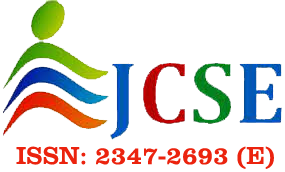Average Spectrum Efficiency of Non-Orthogonal Multiple Access (NOMA) for 5G Wireless Systems
Arpita Gupta1 , Anubhuti Khare2
Section:Research Paper, Product Type: Journal Paper
Volume-7 ,
Issue-5 , Page no. 1513-1517, May-2019
CrossRef-DOI: https://doi.org/10.26438/ijcse/v7i5.15131517
Online published on May 31, 2019
Copyright © Arpita Gupta, Anubhuti Khare . This is an open access article distributed under the Creative Commons Attribution License, which permits unrestricted use, distribution, and reproduction in any medium, provided the original work is properly cited.
View this paper at Google Scholar | DPI Digital Library
How to Cite this Paper
- IEEE Citation
- MLA Citation
- APA Citation
- BibTex Citation
- RIS Citation
IEEE Citation
IEEE Style Citation: Arpita Gupta, Anubhuti Khare, “Average Spectrum Efficiency of Non-Orthogonal Multiple Access (NOMA) for 5G Wireless Systems,” International Journal of Computer Sciences and Engineering, Vol.7, Issue.5, pp.1513-1517, 2019.
MLA Citation
MLA Style Citation: Arpita Gupta, Anubhuti Khare "Average Spectrum Efficiency of Non-Orthogonal Multiple Access (NOMA) for 5G Wireless Systems." International Journal of Computer Sciences and Engineering 7.5 (2019): 1513-1517.
APA Citation
APA Style Citation: Arpita Gupta, Anubhuti Khare, (2019). Average Spectrum Efficiency of Non-Orthogonal Multiple Access (NOMA) for 5G Wireless Systems. International Journal of Computer Sciences and Engineering, 7(5), 1513-1517.
BibTex Citation
BibTex Style Citation:
@article{Gupta_2019,
author = {Arpita Gupta, Anubhuti Khare},
title = {Average Spectrum Efficiency of Non-Orthogonal Multiple Access (NOMA) for 5G Wireless Systems},
journal = {International Journal of Computer Sciences and Engineering},
issue_date = {5 2019},
volume = {7},
Issue = {5},
month = {5},
year = {2019},
issn = {2347-2693},
pages = {1513-1517},
url = {https://www.ijcseonline.org/full_paper_view.php?paper_id=4441},
doi = {https://doi.org/10.26438/ijcse/v7i5.15131517}
publisher = {IJCSE, Indore, INDIA},
}
RIS Citation
RIS Style Citation:
TY - JOUR
DO = {https://doi.org/10.26438/ijcse/v7i5.15131517}
UR - https://www.ijcseonline.org/full_paper_view.php?paper_id=4441
TI - Average Spectrum Efficiency of Non-Orthogonal Multiple Access (NOMA) for 5G Wireless Systems
T2 - International Journal of Computer Sciences and Engineering
AU - Arpita Gupta, Anubhuti Khare
PY - 2019
DA - 2019/05/31
PB - IJCSE, Indore, INDIA
SP - 1513-1517
IS - 5
VL - 7
SN - 2347-2693
ER -
| |
|
|
| 420 | 256 downloads | 154 downloads |
Abstract
Investigating NOMA for conventional downlink and uplink systems, the application of NOMA is investigated in downlink multiuser multiple-input multiple output (MIMO) systems, by proposing a novel MIMO-NOMA model with linear beamforming technique. In this MIMO-NOMA system, users` receive antennas are dynamically grouped into a number of disjoint clusters, and within each cluster a single beam is shared by all the receive antennas those adopt NOMA. The superiority of the proposed model is illustrated through extensive performance evaluations. Finally, the application of coordinated multi-point (CoMP) transmission technique is investigated in downlink multi-cell NOMA systems, considering distributed power allocation at each cell. In the proposed CoMP-NOMA model, CoMP transmission is used for users experiencing strong receive-signals from multiple cells while each cell independently adopts NOMA for resource allocation. The applicability and necessary conditions to use different CoMP schemes are identified under various network scenarios, and the corresponding throughput formulas are derived. The spectral efficiency gains of the proposed CoMP-NOMA model are also quantified.
Key-Words / Index Term
Non Orthogonal Multiple Access (NOMA), Fifth Generation, Spectral Efficiency, 5G Wireless System
References
[1] Linglong Dai, Bichai Wang, Zhiguo Ding, Zhaocheng Wang and Sheng Chen, “A Survey of Non-Orthogonal Multiple Access for 5G”, IEEE Communications Surveys & Tutorials, Vol. 20, Issue 3, PP. No. 2294 – 2323, IEEE 2018.
[2] Y. Cai Z. Qin F. Cui G. Y. Li J. A. Mc Cann "Modulation and multiple access for 5G networks" IEEE Communication Surveys, Vol. 20, No. 1, PP. No. 629-646, IEEE 2018.
[3] S. M. R. Islam N. Avazov O. A. Dobre K.S. Kwak "Power-domain non-orthogonal multiple access (NOMA) in 5G systems: Potentials and challenges" IEEE Communication Surveys, Vol. 19, No. 2 PP. No. 721-742, IEEE 2017.
[4] S. M. R. Islam M. Zeng O. A. Dobre "NOMA in 5G systems: Exciting possibilities for enhancing spectral efficiency" IEEE 5G Tech Focus, Vol. 1 No. 2 pp. 1-6, Jun. 2017.
[5] Z. Ding et al. "A survey on non-orthogonal multiple access for 5G networks: Research challenges and future trends" IEEE J. Sel. Areas Communication Vol. 35, No. 10, PP. No. 2181-2195, Oct. 2017.
[6] Z. Wei J. Yuan D. W. K. Ng M. Elkashlan Z. Ding "A survey of downlink non-orthogonal multiple access for 5G wireless communication networks" ZTE Communication, Vol. 14, No. 4, PP. No. 17-23, IEEE 2016.
[7] M. S. Ali H. Tabassum E. Hossain "Dynamic user clustering and power allocation for uplink and downlink non-orthogonal multiple access (NOMA) systems" IEEE Access, Vol. 4, PP. No. 6325-6343 2016.
[8] M. S. Ali E. Hossain D. I. Kim "Non-orthogonal multiple access (NOMA) for downlink multiuser MIMO systems: User clustering beamforming and power allocation" IEEE Access vol. 5 pp. 565-577 2016.
[9] Linglong Dai, Bichai Wang, Yifei Yuan, Shuangfeng Han, Chih-Lin I, and Zhaocheng Wang, “Non-Orthogonal Multiple Access for 5G: Solutions, Challenges, Opportunities, and Future Research Trends”, IEEE Communications Magazine, 2015.
[10] A. Benjebbour, K. Saito, A. Li, Y. Kishiyama, and T. Nakamura, Non-orthogonal multiple access (noma): Concept, performance evaluation and experimental trials," in Wireless Networks and Mobile Communications (WINCOM), 2015 International Conference on. IEEE, 2015.
[11] K. Higuchi and A. Benjebbour, “Non-orthogonal multiple access (noma) with successive interference cancellation for future radio access", IEICE Transactions on Communications, vol. 98, no. 3, pp. 403{414, 2015.
